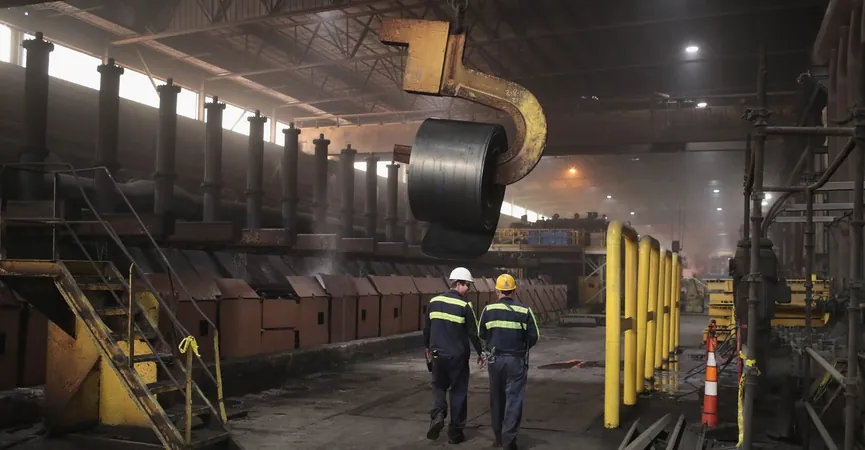
The Truth About America's Manufacturing Jobs: Are They Really Gone For Good?
2025-04-16
Author: Ying
The Promises of Protectionism: A Broken Dream
During his presidency, Donald Trump made bold claims about revitalizing American manufacturing, declaring, "Jobs and factories will come roaring back into our country!” His administration implemented tariffs with the hope of reshoring jobs and boosting the domestic industrial base. This protectionist vision, while appealing, is built on a shaky foundation.
The Reality: A Shift Beyond Tariffs
Despite cries for protectionist measures from both sides of the aisle, including Democrats like Chris Deluzio, who seeks to embrace tariffs as a means to revitalize manufacturing, the harsh reality is that these policies are unlikely to reverse the long-term decline in manufacturing jobs. Tariffs have shown themselves to be largely ineffective, failing to produce the promised job growth while often resulting in job losses in other sectors.
A Global Shift: Manufacturing Employment on the Decline
The decline in manufacturing jobs is not a uniquely American phenomenon. Across rich nations, a transition away from manufacturing is underway, driven by rising productivity and diminishing demand for many goods. This trend parallels what has occurred in countries like Germany, highlighting that the decline in manufacturing is more about economic evolution than poor trade policies.
Understanding Economic Sectors: The Shift to Services
Economists classify national economies into three main sectors: primary (agriculture), secondary (manufacturing), and tertiary (services). As countries grow wealthier, employment in agriculture declines, and a similar pattern emerges in manufacturing as economies evolve. Recent studies show that advanced nations are increasingly leaning towards service-oriented jobs, reinforcing the notion that this shift is a natural economic progression.
The Trade Debate: Is it Really the Culprit?
Populist narratives suggest that trade agreements have offshored manufacturing jobs to cheaper labor markets. However, a closer inspection reveals a more complex scenario where productivity gains, and not merely trade competition, are primary drivers of job loss. Research indicates that increasing productivity in manufacturing is the key factor behind employment declines, eclipsing the role of international trade.
Global Manufacturing Jobs: Peaked and Declining?
Recent data analysis suggests that global manufacturing employment peaked around 2013 and has since declined—an indicator that this trend is not limited to the United States. Thus, even the argument that jobs have moved overseas falls flat when viewing global employment trends.
Manufacturing vs. Manufacturing Jobs: A Critical Distinction
While maintaining a robust manufacturing sector is crucial for economic sustainability and national security, this does not equate to creating high levels of manufacturing jobs. Advanced technologies and automation mean that productivity will rise, often at the expense of traditional assembly line jobs. The focus should be on fostering innovation while recognizing that the quantities of jobs may not return to previous levels.
Conclusion: Embracing the Future of Work
As we navigate the complexities of a changing economy, it’s vital to acknowledge that the landscape of work is evolving. Manufacturing holds essential value, but our expectations must align with the realities of automation and economic growth. The future isn't about returning to the past; it's about adapting to the new opportunities that lie ahead.


 Brasil (PT)
Brasil (PT)
 Canada (EN)
Canada (EN)
 Chile (ES)
Chile (ES)
 Česko (CS)
Česko (CS)
 대한민국 (KO)
대한민국 (KO)
 España (ES)
España (ES)
 France (FR)
France (FR)
 Hong Kong (EN)
Hong Kong (EN)
 Italia (IT)
Italia (IT)
 日本 (JA)
日本 (JA)
 Magyarország (HU)
Magyarország (HU)
 Norge (NO)
Norge (NO)
 Polska (PL)
Polska (PL)
 Schweiz (DE)
Schweiz (DE)
 Singapore (EN)
Singapore (EN)
 Sverige (SV)
Sverige (SV)
 Suomi (FI)
Suomi (FI)
 Türkiye (TR)
Türkiye (TR)
 الإمارات العربية المتحدة (AR)
الإمارات العربية المتحدة (AR)